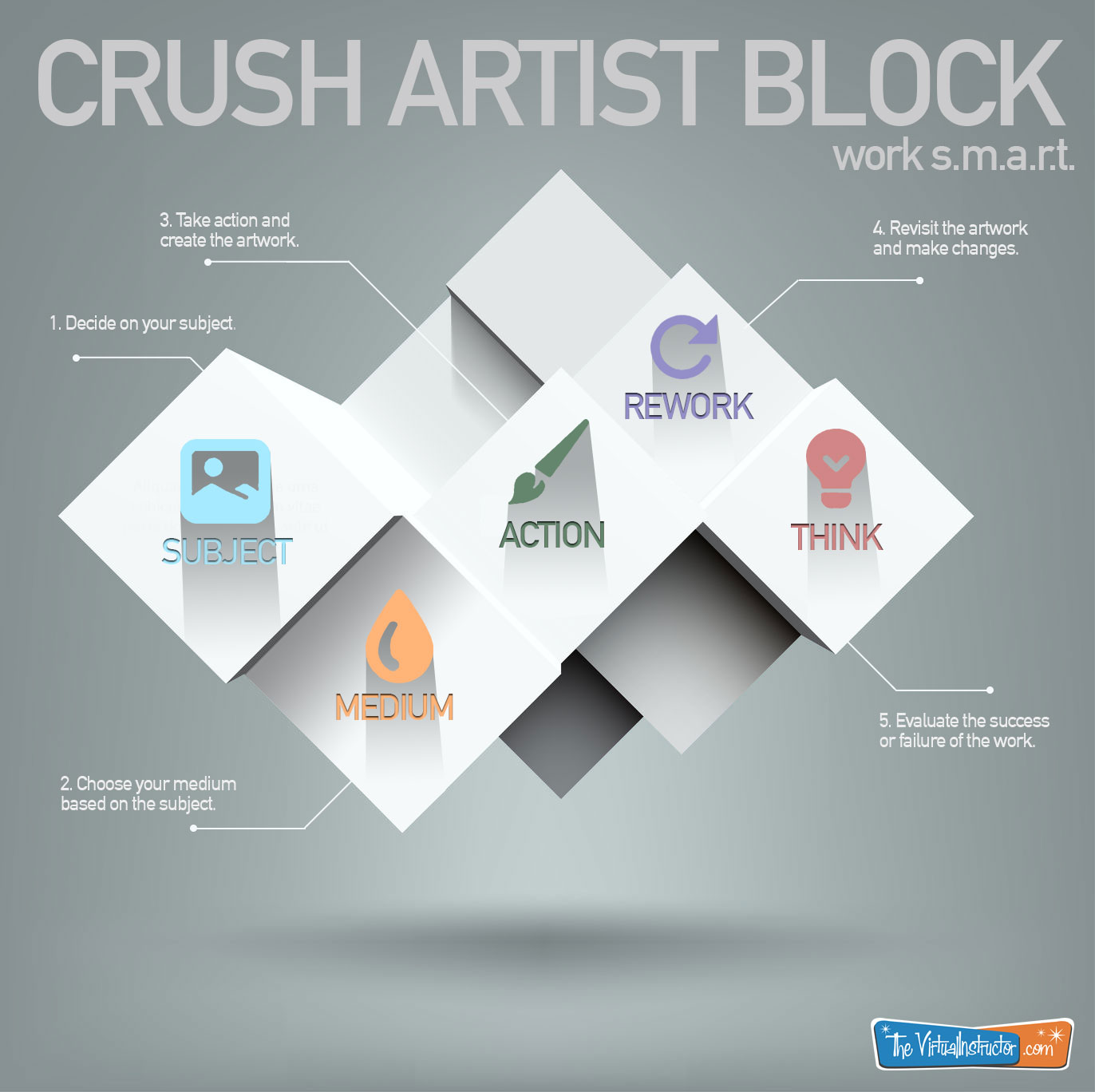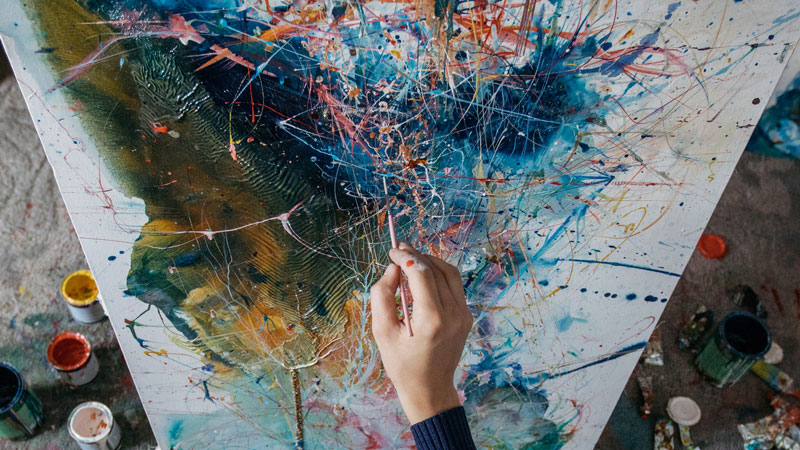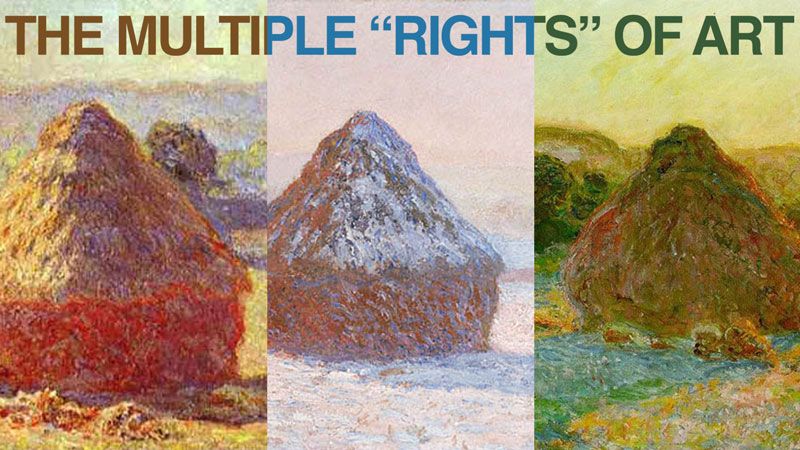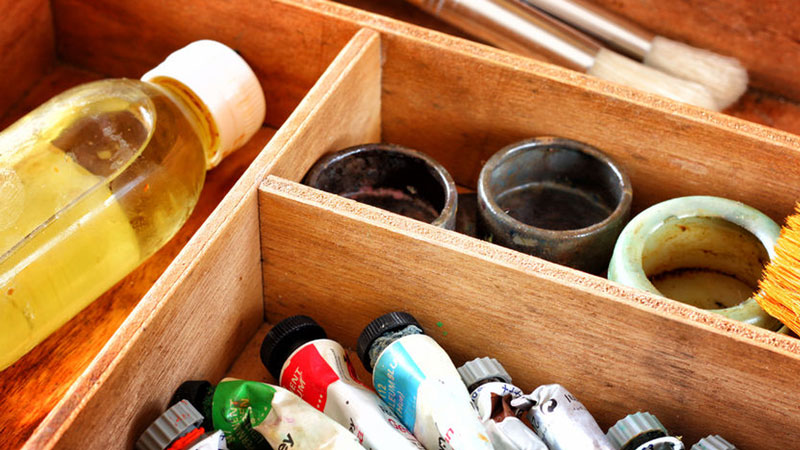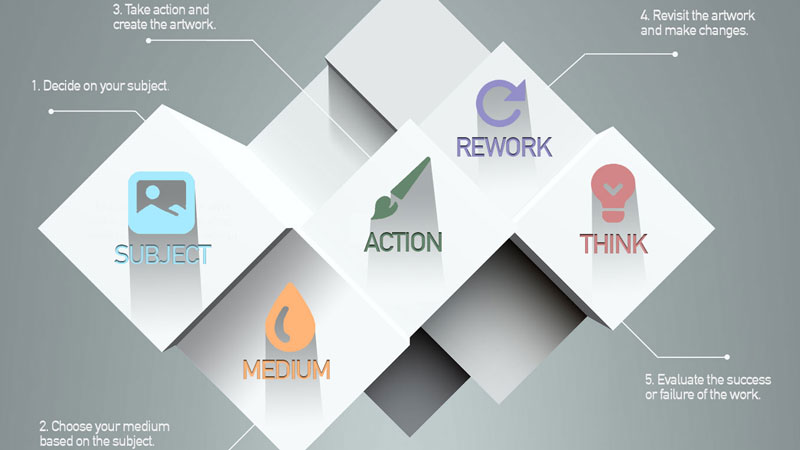
You sit down to work and then it hits you.
Like a massive semi-truck barreling down the road at 75 miles per hour, the blank paper or canvas smacks you square in the face. You are now in “gridlock” – stunned and frozen by some mysterious force. You feel helpless and a little panicked as the white of the surface grows brighter and more intense. A sense of urgency grows inside. You look around as if you’ll see something to inspire you but nothing seems to spark. You don’t want to waste this creative motivation that you feel and it’s time to work, but nothing – just nothing.
Frustration comes next. Then hopelessness, as you feel the time drip away. Your creative juices turn to sludge. The motivation that you felt just moments before is fading. The diagnosis is bleak – you have “artist block”.
It happens to us all. As artists, we all face this dilemma from time to time. It’s part of being a creative person. It can feel so depressing when it happens. It’s amazing how strong the desire to create can be and how much pressure we often place on ourselves to produce.
Fortunately, there are ways to combat artist block. You can learn to absolutely crush it when it rears its ugly head, and put the beast away forever.
Before we delve into a few strategies, let’s examine what’s causing the issue in the first place.
Factors That Contribute to Artist Block
Artist block occurs when a few factors come together and join together to create a “perfect storm” of sorts. When these factors all happen simultaneously, artist block happens. The problem is that when they set in, the strength of enemy just grows and it’s hard to escape.
“Creativity needs to breathe. It becomes smothered when you place a time limit on it.”
The biggest factor is the pressure that you have placed on yourself. For many artists, the feeling to create something that is better than what they created before is very real. For some reason, many of us feel that we have to “one up” our previous artworks with every new thing that we produce.
Although having that aspiration is good, it can be a contributor to artist block. Just like it’s sometimes a bad idea to compare yourself to other artists, it’s also not good to compare yourself with yourself. You shouldn’t place unnecessary pressure on yourself to perform miracles with your art on every attempt.
While some pieces of art may change the world, the likelihood that your next work is going to be one of them is slim. So relax. The art that you create doesn’t have to be a thesis on the meaning of life.
Another factor is a lack of time. Have you ever noticed that artist block usually happens when you are on a deadline or have limited time. The limitation of time can make you feel a sense of urgency that can destroy creativity.
Creativity needs to breathe. It becomes smothered when you place a time limit on it.
To allow your creativity to breathe, plan ahead. Create a schedule for making art. Block out chunks of time to work and write them in calendar. That way you know, in the back of your mind, if you don’t produce today, there’s another opportunity scheduled in the future. You’ll be surprised how far this little bit of assurance can go.
A third factor is an obsession with materials. I know that this one sounds a bit strange, but let me explain.
Some artists are just media freaks. They collect art materials and feel the need to use them without having a plan or reason to. It’s no wonder that when they sit down to work, nothing happens. There was no creative spark in the first place – just an urge to use that new medium that they purchased.
Now I love materials as much as the next artist, but we need to realize that art materials are tools of communication. We need to know what we want to say, before we decide how we are going to say it.
You wouldn’t go to the hardware store and buy a hammer and then go home and decide what you are going to build with it.

Decide what you are going to create first, then decide what materials will help you get the job done.
Work S.M.A.R.T.
To help overcome the perils of artist block, consider approaching your work as a process.
I like to think of the approach that I use as an acronym – S.M.A.R.T.
SUBJECT – Before even considering the medium or the technique, first decide on the subject. The subject of your work should influence the medium that you will use and the approach that you will take, so it only makes sense to start here.
If you are working from a photo reference, create it first. If you are working from life, find your subject.
If you haven’t got a subject in mind, then it’s not time to sit down and work.
Artistic inspiration will almost never happen while you’re sitting at an easel. Instead, it will strike when you least expect it. It may happen in the shower, at the park, or while you’re driving. But don’t expect it to descend from the heavens when you’re ready to paint.
In order to harness all of your ideas, consider carrying around a small notebook. Most of us have smart phones that keep our notes for us as well. I like to use an app called Evernote to keep up with my “moments of inspiration”.
Evernote is great because when I have an idea, I can just speak into the phone and it is saved. You can even add photos or handwritten notes. When I’m ready to work, I open the app and scroll though all of my ideas.
MEDIUM – Once you have your subject, then it’s time to consider the medium. Many artists prefer just one or two mediums and create art in those mediums exclusively. But others create art using a variety of media.
The manner in which you create marks with a specific media is unique. The strokes that you make while painting a landscape with oils will be different than the ones made by another artist.
“While some pieces of art may change the world, the likelihood that your next work is going to be one of them is slim.”
You need to understand who you are as an artist. We are all different and the way you use the medium will affect the success or failure of your artistic communication.
For example, if I were to create a landscape, the subjects within the reference would influence what medium I would choose. If the reference featured mostly organic objects, like trees, water, or rocks, I would most likely use a softer medium like pastel or oils.
If the landscape had more architectural elements, then I would likely choose a linear medium like pen and ink, graphite, or colored pencils.
ACTION – Now that the subject and medium have been decided, it’s time to take action and produce the work. Because you have done the prep work, the work should flow without any chance of artist block getting in the way.
REWORK – When the artwork is “finished”, plan to revisit it in the near future and make any necessary changes. You need time to let your mind reset and see your work with “a new set of eyes”.
THINK – When the work has been reworked to “perfection”, it’s time to think about the result and consider its success or failure. (Remember, it’s okay to fail.) Take a final look at the art and evaluate what specifically was a success and what was less successful. Ask for other artists’ input and be open to “constructive criticism”. Make notes on what could be improved in your process and make the changes the next time around.
Artist block is a killer, but it usually happens because of a lack of plan. Too often, it’s the result of trying to “put the cart before the horse”.
Let your creative moments happen when they do and don’t force them “on demand”. Make notes when they strike and when it’s time to create – get to work.
If so, join over 36,000 others that receive our newsletter with new drawing and painting lessons. Plus, check out three of our course videos and ebooks for free.


